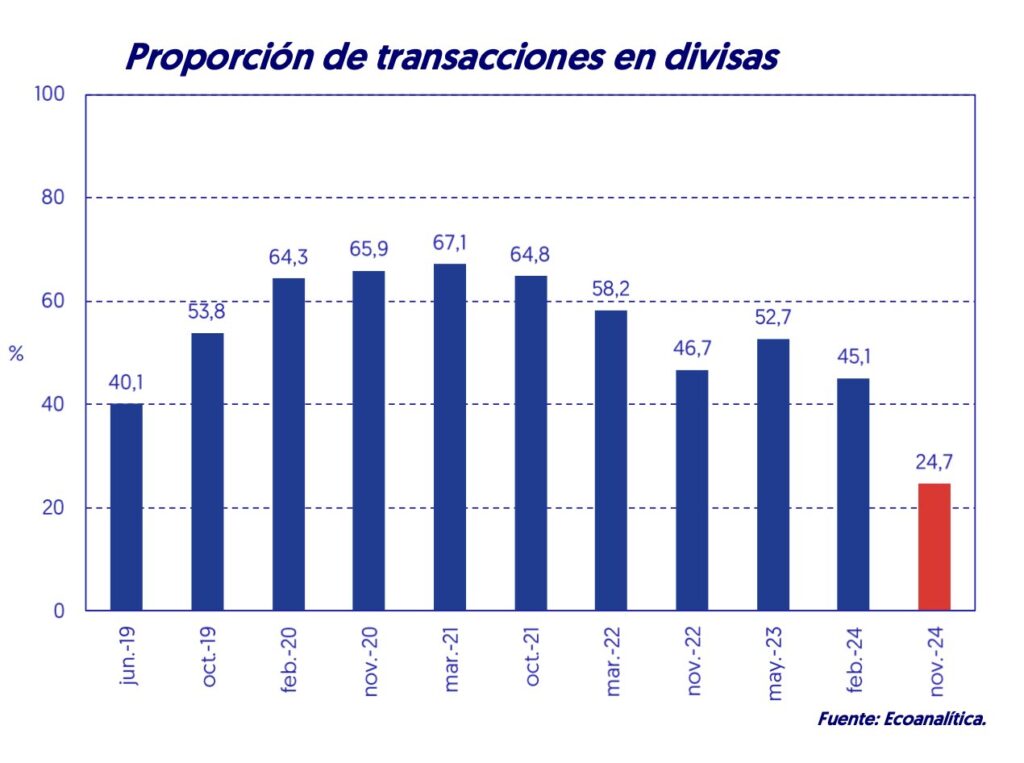Under current economic conditions in Venezuela, everyday transactions are controlled by the bolivar, the local currency. Although it is something logical to think, this occurs in the midst of an economy that, for several years, was practically controlled by the US dollar informally.
According to the most recent study from the socioeconomic analysis firm Ecoanalítica, three out of every four payments made in Venezuela during the month of Novemberwere made in bolivars. Thus, the dominance of the greenback fell to 24.7% during the eleventh month of the year, something unprecedented in the last five years, according to the organization.
The study, which processed more than 45,400 transactions in 10 cities in Venezuela and in a total of 530 commercial establishments, The use of the dollar for everyday payments showed a notable drop. In June 2019, for example, payments in foreign currency represented 40%. That reached a peak in March 2021, of 67.7%.
“From that peak until now there is a very significant drop of 40%,” said Venezuelan economist and partner-director of Ecoanalítica Asdrúbal Oliveros, in a interview recent.


The dominance of the greenback fell to 24.7% during the eleventh month of the year, Source: X.
What is the reason for the fall in the use of the dollar in Venezuela?
According to the Ecoanalítica study, the fall in the use of the dollar in Venezuela for everyday payments responds, in large part, to a phenomenon known as the exchange gap. This is the difference between the dollar quotes at the official rate (governed by the Central Bank of Venezuela) and the parallel rate (governed by the speculative market).
In some cases, This gap has reached 20%. Currently, the official dollar is traded at 50.33 bolivars, almost 10 bolivars less than its informal pair, which is quoted at Bs. 59.20.
As Oliveros sees it, many Venezuelans who have foreign currency prefer to apply arbitration, which in this case is based on exchanging dollars to bolivars at a rate that best suitsinstead of paying in foreign currency at the official rate in stores. “That is the most important factor that explains this significant reduction in the use of dollars,” he said.
This vision is shared by the Venezuelan economist Manuel Sutherland, who in statements to CriptoNoticias highlighted that because the exchange gap is between 5% and up to 20%, “there is a very big advantage in selling currencies in the parallel market and using the bolivars in stores or businesses forced to receive dollars at the official rate.”
For Sutherland, “arbitrage is essential in this transactional picture where people try to squeeze the maximum value out of the currency they have and try to yield the money they manage.”
“This allows you to save up to 20% depending on who buys and who sells,” he said, although he warned that it is a process that “causes discomfort, prevents the economy from being organized and having a certain certainty or minimum exchange-monetary stability and is a response in the face of the economic difficulties that are the result of government policies that constrain the economy and put obstacles and difficulties in its growth.”


Economist Manuel Sutherland believes that the decline in the use of the dollar is transactional. Source: Provide.
It is not a consequence of the tax on dollar operations
Sutherland, like Oliveros, rules out that this decrease in the use of the dollar for daily operations in Venezuela is due to the impact of the Large Transactions Tax (IGTF), a 3% tariff on foreign currency paymentsapplied by the government of Nicolás Maduro with the objective of encouraging the use of the bolivar and increasing tax collection.
In Sutherland’s opinion, “the IGTF is small and many people do not include it in their personal expenses.” Although there are exceptions such as businessmen and people who do carry out large transactions, who try to avoid it, he explained.
“This implies that they prefer to sell currencies in the parallel market, they take bolivars and avoid the IGTF in large transactions, which generates minimal savings,” he said.
Now, using bolivars over US dollars for everyday payments also has its disadvantages. Among them, that the Venezuelan economy now becomes more vulnerable to devaluation than before “because many companies and companies have many more bolivars,” says Oliveros, remembering that this is a currency that has lost 99% of its value over the course of 20 years.
This is shared by Venezuelan consumers themselves, who have reacted to the Ecoanalítica data. This is the case of Marcos Pérez, who on Instagram commented that this decrease in the use of the dollar for payments “is a very negative fact for the economy” since the bolivar “does not allow value to be preserved over time.”
In any case, this current economic circumstance, in which the bolivar exceeds the US dollar in daily operations, “is a purely transactional phenomenon due to the exchange gap” since when the gap expands “people prefer to exchange dollars for bolivars,” Sutherland declared.
“In my opinion, it is something purely transactional, the result of learning from the years of hyperinflation and how people have learned to overcome the monetary and exchange disaster in recent times,” the specialist emphasized.
USDT gets into the game
Amid the issue of arbitration and the exchange gap, as well as the decrease in the dollar in Venezuela for daily operations, the name of a stable Cryptocurrency linked to the greenback stands out. It is about USD Tether (USDT), which has been one of the most predominant in the Venezuelan market.
The relevance that USDT has gained in Venezuela is so great that the price of the USDT-VES pair in the peer-to-peer (P2P) market of Binance, the largest cryptocurrency exchange on the market, It is used to average the price of the parallel dollar. In general, the price of USDT in bolivars resembles the informal quote of the US currency, which is positive for those who use these assets from Venezuela.


The price of the parallel dollar takes into account the price of the USDT-VES pair on Binance. Source: Instagram.
As Manuel Sutherland sees it, in Venezuela there are those who use USDT to bring money from abroad, transfer and move funds, “due to the extremely strong restrictions that the government imposes, with regulations that make trade difficult.”
The economist points out that USDT “facilitates arbitrage”, allowing users to “yield a little more on their currencies”, without falling into the complications of the Venezuelan financial system, where people who have foreign currency accounts in a traditional bank cannot transfer dollars to another bank account in foreign currency.
Now, although the use of USDT has grown, the presence of this alternative in the Bitcoin/” target=”_blank” rel=”noreferrer noopener”>Bitcoin It is not so palpable in the Venezuelan economic situation.. This is so since, according to Ecoanalítico, payments made with cryptocurrencies They only addressed 1.8% of transactions executed by currencies during the month of November, where the bolivar and the dollar covered more than 90% of the use case.
Whatever it may be, USDT is already part of that Venezuelan economic dynamic led by the disparity in exchange rates. A scenario that, generally, ends up affecting the final consumer.
This is explained because, although users benefit from having physical or digital currencies that they can exchange at a parallel rate, they continue to see, at the same time, the rapid increase in products and services in commercial premiseswhich do nothing other than seek to close the economic gap that shakes, like an earthquake, their financial bases.
Crypto Keynote USA
For the Latest Crypto News, Follow ©KeynoteUSA on Twitter Or Google News.







